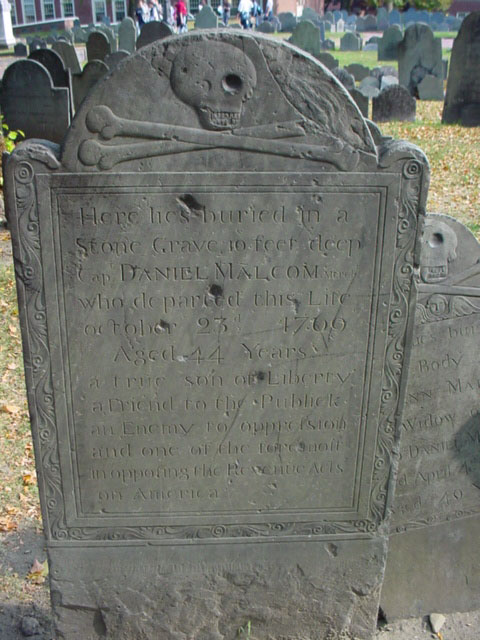Indeed, it’s one of the featured attractions there, with signage pointing out how the stone is pitted, reportedly by British soldiers’ musket balls.
The uppermost round mark on the stone was produced by the carver, not by a musket. It’s the eye socket of the skull facing right. A very similar design appears on Ann Malcom’s stone nearby and on the Rev. John Barnard’s gravestone in Marblehead, both from 1770.
But there’s clearly other damage to the Daniel Malcom stone, divots in the middle of the text. I went looking for more information about those marks and was surprised by what I found.
The earliest printed mention was a note in the back of Urania: A Rhymed Lesson, a poem published by Oliver Wendell Holmes, Sr., in 1846, seventy years after the British military evacuated Boston. It quoted Malcom’s marker and added:
The gravestone from which I copied this inscription is bruised and splintered by the bullets of the British soldiers.I’d be pleased to hear about earlier mentions. Unlike a quotation or phrase that one can search for exactly, this fact could be stated in many ways.
A couple of years after Holmes’s poem, the April 1848 issue of the New England Historical and Genealogical Register stated:
There are marks upon the stone, and tradition says that the British soldiers made use of it as a target during their occupation of Boston, at the commencement of the Revolution.The 4 Aug 1849 Boston Statesman newspaper quoted this item from the reformist Boston Chronotype:
Mean Revenge.—During a stroll through Copp’s Hill burying ground, a few days ago, a gentleman directed our attention to the following inscription on a grave stone:— . . .That article was reprinted later that year in Scientific American.
The stone exhibits marks of violence, and our informant—who is an antiquarian, versed in the genealogy of almost every family buried on Copp’s Hill—stated that Capt. Malcolm [sic] had rendered himself extremely obnoxious to the British troops, and that a short time after his death a file of soldiers was drawn up and discharged a volley of musketry at his grave stone. Our informant said that in his younger days he had heard several eye witnesses related the story. The marks of the balls are distinctly visible at the present day. We might search long to find a more despicable species of revenge than this.
Assuming this story was accurate, the next question is when such vandalism took place. Malcom died in 1769, when British regiments were in Boston and his defiance of royal authority was recent. Those soldiers (or officers) might have seen Malcom in action. But if people had seen redcoats shooting at his grave then, there would surely be complaints in the vigorous local press.
Vandalism would more likely have gone unreported during the siege of Boston, with no opposition newspapers in town and bigger stories to print. That would mean the soldiers (or officers supervising them) were angered by the “true Son of Liberty” phrase on the stone rather than direct knowledge of Daniel Malcom.
Yet another possibility is that the damage was produced by something other than British muskets, but saying that made for a better story. The unnamed “antiquarian” in 1849 referred to “several [unnamed] eye witnesses” to the actual shooting, however.
I’d also like to know when the plaque for Malcom, shown here, was put up inside Old North Church. It refers to him being “Safe from British Bullets.” Was that an allusion to the scars on his gravestone nearby?
COMING UP: John Malcom’s welcome to Newport.

I've told this story many times myself, but I must admit that I have my personal doubts.
ReplyDeleteWouldn't the slate gravestone be more likely to shatter upon the impact of the musket ball, rather than simply suffering a bruise?
Of course, it would depend on the range, and on the angle. But muskets of the day were notoriously inaccurate; so it seems that a shooter intent on vandalism would fire from a close range and a direct angle.
I'd be interested in hearing more about this from re-enactors and other individuals who are more familiar with the physics of musket fire.
As for the memorial in the Old North sanctuary, I suspect that the church records might give the installation date.
Keep up your good work, John!
This might indeed be a project for some experimental archeology using muskets and a similar sort of stone (not already carved).
ReplyDeleteWhile not a controlled experiment, this article looking at historic damage to stone sheds some light on the matter and makes claims the damage to Malcom's headstone was caused by musket balls at least seem plausible:
ReplyDeletehttps://heritagesciencejournal.springeropen.com/articles/10.1186/s40494-018-0200-7